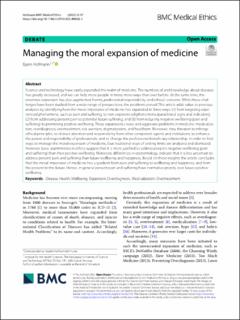| dc.description.abstract | Science and technology have vastly expanded the realm of medicine. The numbers of and knowledge about diseases has greatly increased, and we can help more people in many more ways than ever before. At the same time, the extensive expansion has also augmented harms, professional responsibility, and ethical concerns. While these challenges have been studied from a wide range of perspectives, the problems prevail. This article adds value to previous analyses by identifying how the moral imperative of medicine has expanded in three ways: (1) from targeting experienced phenomena, such as pain and suffering, to non-experienced phenomena (paraclinical signs and indicators); (2) from addressing present pain to potential future suffering; and (3) from reducing negative wellbeing (pain and suffering) to promoting positive wellbeing. These expansions create and aggravate problems in medicine: medicalization, overdiagnosis, overtreatment, risk aversion, stigmatization, and healthism. Moreover, they threaten to infringe ethical principles, to distract attention and responsibility from other competent agents and institutions, to enhance the power and responsibility of professionals, and to change the professional-beneficiary relationship. In order to find ways to manage the moral expansion of medicine, four traditional ways of setting limits are analyzed and dismissed. However, basic asymmetries in ethics suggest that it is more justified to address people’s negative wellbeing (pain and suffering) than their positive wellbeing. Moreover, differences in epistemology, indicate that it is less uncertain to address present pain and suffering than future wellbeing and happiness. Based on these insights the article concludes that the moral imperative of medicine has a gradient from pain and suffering to wellbeing and happiness, and from the present to the future. Hence, in general present pain and suffering have normative priority over future positive wellbeing. | en_US |

